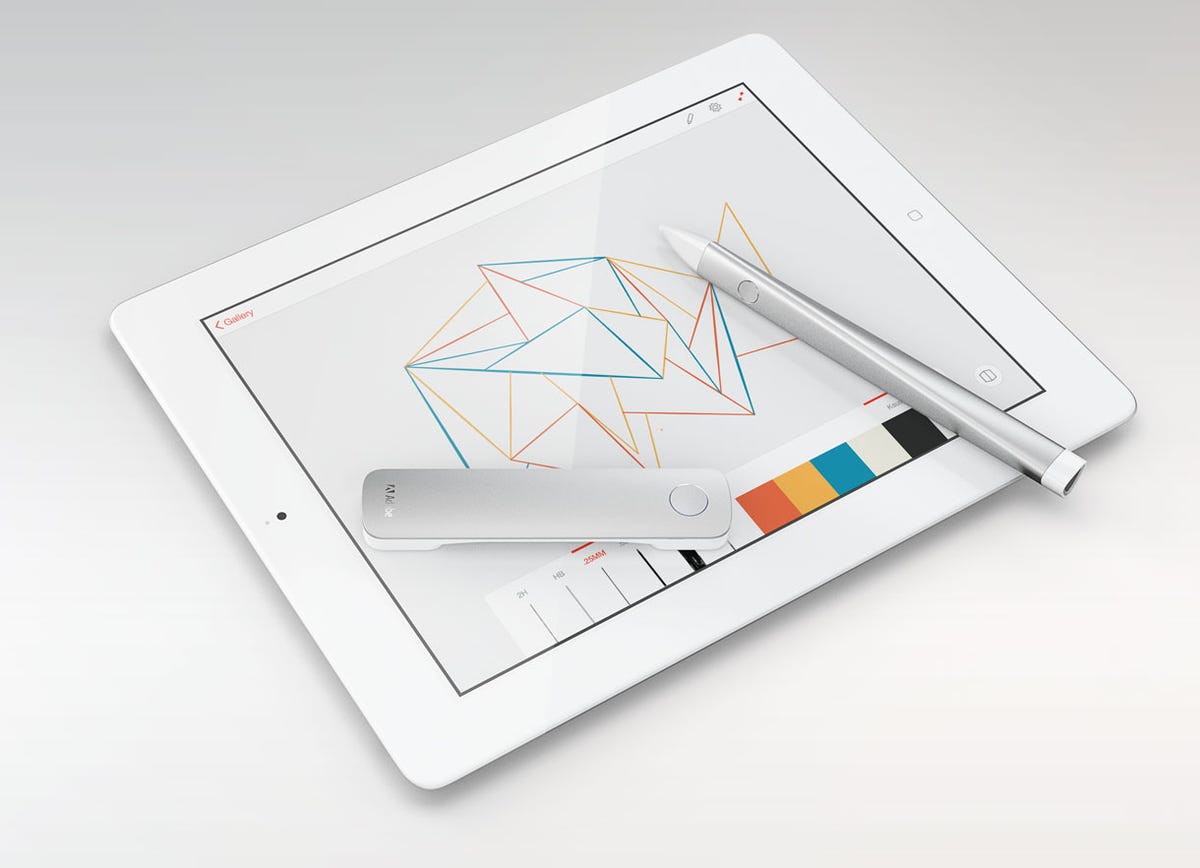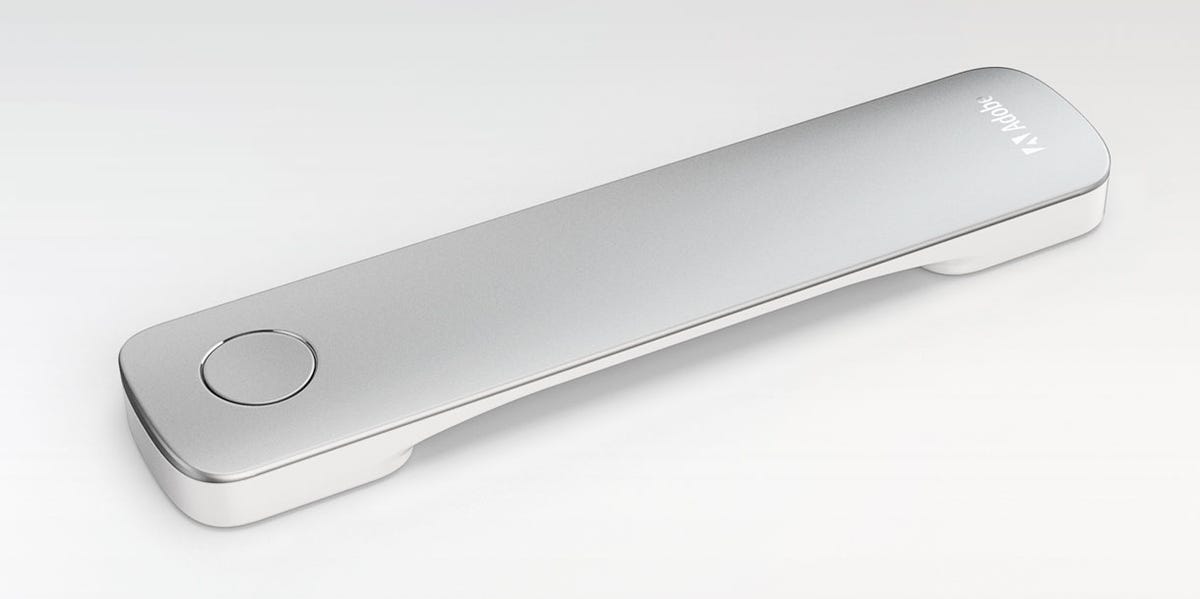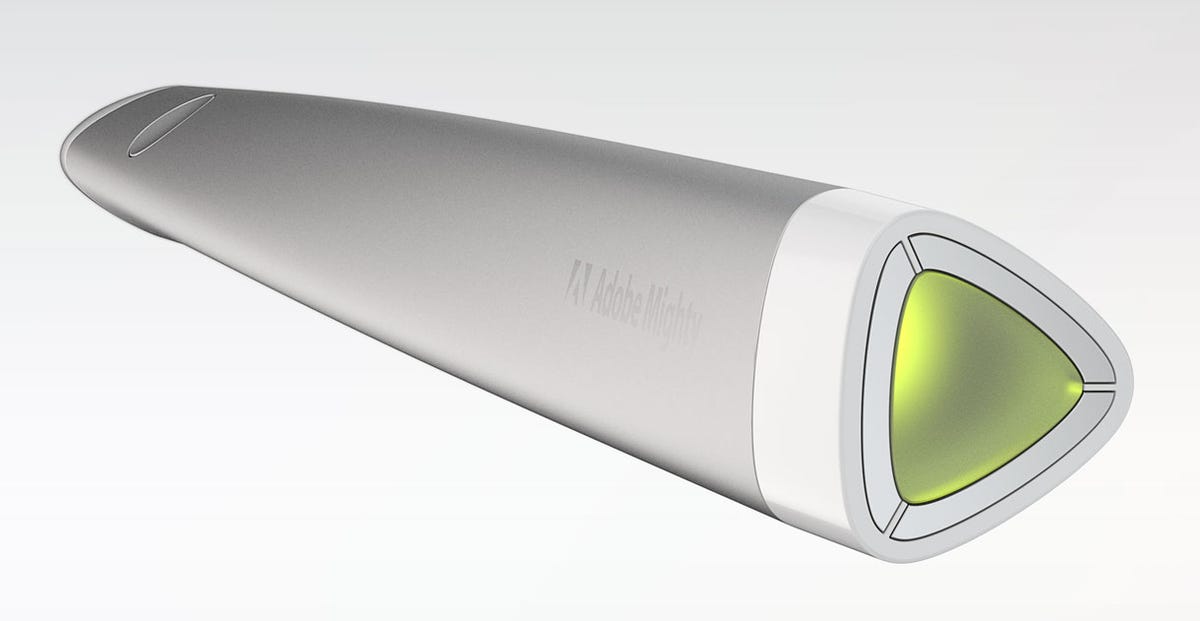Like Google and Microsoft, Adobe Systems has been bitten by the hardware bug.
The software company announced Tuesday that it will begin selling its Mighty digital pen — a stylus for iPads that it first demonstrated in prototype form in May. And it announced two new iOS app prototypes, Parallel and Contour, that make use of the Mighty and a related Adobe hardware product, a digitally connected ruler called Napoleon.
The Mighty is designed to close the gap between drawing on paper and using a tablet, with a Bluetooth link to the tablet software and drawing technology that Michael Gough, Adobe’s vice president of experience design, said is precise and responsive.
“It’s kind of surprising how good it feels to get that tactile feedback while you’re drawing. I think there’s going to be a lot of analog in the next generation of digital tools,” said Gough.
The Bluetooth link can communicate pen status information such as how much pressure an artist is exerting on it, and it also optionally links out to Adobe’s Creative Cloud service. That brings network-based features such as tools that import a pen user’s color-scheme ideas or elements copied to a virtual clipboard.
The Mighty is geared to attract the next generation of creative types — a potentially much larger market with an Instagram-trained population willing to experiment.
“When you were three or four or five years old, you could draw, then one person told you your drawing was crap, and you stopped,” Gough said. “A number of new platforms and tools out there are convincing a generation that they’re all creative. A new motivation for Adobe is to make it possible to feel creative and, in the case of Mighty, convince people that they can draw.”


Adobe Systems
Adonit partnership
Adobe has signed a partnership with Adonit, maker of the Jot tablet stylus, to make the Mighty, Gough said. One of the changes in the new version is a tip that’s narrower than the original’s 5-millimeter width, he said.
Related stories
- Here’s How Adobe’s Camera App for Serious Photographers Is Different
- Adobe Tool Makes it Easier to Post Videos to Instagram, Facebook, Twitter
- Amp up your creative skills with this $30 Adobe Creative Cloud training bundle
- Adobe’s new Creative Cloud Express helps you make zippy, peppy graphics
- Lightroom on Apple’s M1 Max Mac: Holy mackerel, this is fast
“They brought interesting technology to bear, and we brought interesting technology to bear,” Gough said. “They seemed very aligned [with Adobe] around the idea that hardware drives software and software drives hardware in this virtuous cycle.”
Adobe debuted Mighty at its Max conference in May along with the Napoleon digital ruler, which also interacts with tablet software so people can create not just straight lines but also shapes and other figures. Adobe said it will bring Napoleon to market, but it wouldn’t commit to a particular ship date. Unlike with Mighty, there’s not a ready supply of existing technology companies already in the market.
The two new iPad apps are designed to take advantage of the hardware devices’ abilities. Parallel is a drafting app, and Contour is designed to capture shapes from people’s photos so they can be imported into Parallel. By releasing a software developer kit, Adobe expects others to build software that use the devices, Gough said.
“We’ll build communities around these apps and enable other people to make apps and services like [them],” Gough said.
Though Adobe’s devices can benefit from a Creative Cloud subscription, the company hasn’t worked out what to make freely available. Such devices will work better with the $50-per-month Creative Cloud subscription, though, and Adobe hopes to see others developing hardware that takes similar advantage, Gough said.
Pricing also remains undisclosed. Higher-end digitization technology is often priced for professionals — technology such as Wacom’s tablets — though that company seems interested in selling small tablets for creative types and has ventured into the tablet stylus market with the $99 Intuous Creative Stylus.
The Mighty has a variable-color LED opposite its drawing tip. It’ll change to communicate different information to the user, said Geoff Dowd, the project’s design leader. For example, occasional yellow pulses means the battery needs charging, blue means it’ll ready to be connected over Bluetooth, and a double pulse of color confirms that its user successfully used it to copy information to a virtual clipboard.
It comes with a protective sheath that also serves as a USB charger. It’s got an LED status light, too; it’ll cycle through the rainbow spectrum when the pen becomes fully charged.


Adobe Systems
Adobe, the hardware company?
For much of the last two decades, many hardware and software companies were separate. Companies like Intel, Dell, and HP built the hardware; those like Microsoft, Adobe, and Red Hat handled the software. But the boundaries are blurring as more companies adopt both: Microsoft building its Surface and acquiring Nokia’s handset business, Google moving from making Android to selling Android phones, Samsung developing the Tizen OS.
The model many have in mind, of course, is Apple’s, where a single company profits handsomely by closely integrating the bits and the atoms to ensure everything works well together. But it’s actually more common than you might think in the overall computing industry: IBM has done it for decades with its servers, Cisco has likewise with network equipment, and storage companies like NetApp and EMC supply hardware and software.
Adobe, though, has a different model in mind.
It doesn’t want to become a hardware company — indeed, Gough made Adobe sound somewhat reluctant about the move. Instead, the idea behind Mighty and Napoleon is to prod the industry toward new styles of expression.
“We’re doing the minimum amount of hardware necessary to be a better software company, Gough said. “We have no intention of becoming a hardware company.”


Adobe Systems
Correction at 2:17 a.m. PT September 18: Adobe has committed to bring the Napoleon ruler to market, but hasn’t said when.



